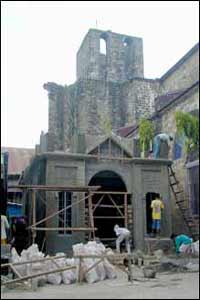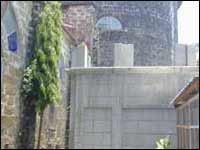The
Philippine Star
March 6, 2004
LIFESTYLE FEATURE - Modern Living
CITY SENSE By Paulo Alcazaren
Context and controversy
Lapu-Lapu will not leave me alone. I'm still getting e-mails and text
messages about that statue and its setting in the Luneta. Apparently,
a metal version of the huge statue is being cast to replace the plastic
one. Be that as it may, metal or plastic, the point is that the statue
and its setting are not appropriate for that site. A good number of Cebuanos
believe that the great warrior should stay in Mactan (and that his monument
there be improved and better maintained) while many here prefer that Jose
Rizal be kept the doctor-in-residence of his eponymous park.
It's all a matter of context. The right personage for the right place
should be the rule in constructing our monuments to great men (notice
how few there are to women? Maybe it's because it's the men who do the
choosing). Context is also a matter of physical design, which should be
the job of a landscape architect or urban designer and not some clerk
or draftsman with no experience with designing settings for sculpture.
Context works for new sculptures and monuments in parks as well as for
any additions to heritage sites or historic complexes such as Catholic
churches. Remember the brouhaha the other year over a fast-food restaurant
built inside church grounds? Another case is brewing on the Taal Basilica
grounds. But before we get to that, let¹s look at how such aspects
of context and site design can be properly implemented.
De La Costa On CampusAnew monument to the great Jesuit scholar Horacio
V. de la Costa has just been inaugurated at the Ateneo de Manila campus
in Diliman (I wonder why it was never renamed Ateneo de Diliman). The
statue is the creation of Imao, the very same sculptor who did the Lapu-Lapu
monument. Unlike the Rizal Park incongruity, the setting for this statue
is perfectly in sync with the site both in terms of its physical scale
and design as well as historical context.
The statue and its simple and elegant marker in black granite are located
beside a small open space in front of a building named after Fr. de la
Costa and across from the Rizal Library. The statue is life-sized and
stands (literally) on a simple pad at ground level representing
how the scholar-priest made himself and his body of work immeasurably
accessible to generations of students and fellow scholars.
The setting is worked into the pedestrian entrance to the building in
a transitional space that helps tie this entry with the green space beside
it. This "commons" is popular with faculty and students alike
because it provides pleasant views, shade and many seating nooks, which
are smoke-free (the campus allows smoking only in designated "smoking
corners," much to the consternation of a few, like fellow-Star columnist
Krip Yuson, whom I bumped into while taking pictures of the statue).
The memorial was the project of Batch '52 of the Ateneo High School led
by Totit Olivares. The memorial was inaugurated last Feb. 17 and comes
a year after Harvard-trained historian Bobby Paterno's wonderful four-volume
Horacio de la Costa book set was released. Not a month after the statue
made its appearance, Fr. de la Costa is already at home with students,
faculty and surroundings.
From a memorial to a "Gentle Giant" of a man who made sure we
got our history in context to a new chapel that is out of physical context
in a historic site, we go to Taal.
Controversy Erupts In Taal. Taal is a peaceful town blessed with heritage
that rivals Vigan in terms of architecture and culture. All is not well
in Taal because of a brewing controversy. A new "adoration/vigil"
chapel is being built on the grounds of Taal's famous Basilica. Despite
options for locating the said chapel elsewhere, parish authorities have
proceeded with the construction of the structure in an area that compromises
the historical integrity of the centuries-old church structure and setting.
Heritage structures are not only made up of an old building and its foundations.
More often than not, the heritage lies in the complete package of building,
its interiors, its site, any gardens of plazas and, sometimes, adjoining
heritage buildings and the whole district itself. It is these spaces that
are needed to set and retain the structures' context. As a gem is made
less valuable without a proper setting, the same goes for architecture.
Philippine colonial churches represent a layer of our complex culture
and history. These churches, paraphrasing the historian Horacio de la
Costa, "stood for the single most important influence on people's
lives their faith." This representation of that past zeitgeist
of our communal lives lay in both structure and site of historic churches.
Notice how much is lost when urbanization and incongruous (to use the
word again) architecture erode the integrity and bearing of many a solemn
baroque facade.
The local bishop was reminded by the National Historical Institute, headed
by Ambeth Ocampo, that any addition would have to be vetted by the NHI
to ensure that there would be minimal impact on the site and building's
heritage value. A similar letter was sent by concerned citizens, led by
Taal-born sculptor Ramon Orlina, pointing to requirements outlined in
P.D. 1505 regarding such planned additions while acknowledging the fact
that modern needs should be met.
Neither call was heeded. The NHI and the citizens even proposed several
options, any of which would accommodate the new functions required. These
options suggested adaptive-reuse of existing space (the first possibility
that should be considered with any historic site or building) and other
locations not the courtyard of the Basilica, which is an integral
setting and open space that defines its character and value.
The building of the new structure continues as we speak. Taal's plight,
to a lesser or greater degree, is repeated in hundreds of towns and cities
and their church grounds, parks, plazas, heritage structures, monuments
and landmarks. The law seems to bend to the rule of whoever is in power
locally, making a mockery of our democratic system and holding heritage
hostage to the caprices of misdirected mayors, profit-blinded millionaires
and unchristian monsignors alike (not that the Taal authorities are any
of these).
Only God knows what will happen to our historic sites and structures,
along with our faith in religious and political leaders, if this trend
continues. One day, we may have to call on the ghost of Lapu-Lapu to defend
us and our heritage against our own fellow Filipinos. It should be easy
to awaken him. He¹s already turning in his grave.
* * *Feedback is welcome. Please e-mail the writer at citysensephilstar
@hotmail.com.

